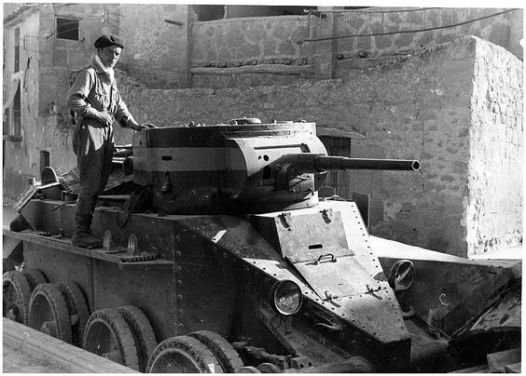Andreu Nin, the leader of the POUM is assassinated. After being held for four days in a secret Communist prison in Alcála de Henares and tortured, Soviet KNVD members kill Nin. Nin never gave the Soviets the information they interrogated him and his fellow members for, or never had the information. The exact details of Nin’s killing will never be fully established. Nin had been the leader of the POUM (Workers’ Party of Marxist Unification) for two years, and stood against fascism and Stalinism, and in favour of workers and peasants’ rights. Nin’s death by Soviet agents marked the demise of both the POUM and its revolutionary movement. Hundreds more are killed or imprisoned after Nin’s death. While Communists and anti-Stalinists are technically both anti-fascist and against Franco’s Nationalists, the constant fighting between leftist factions is a huge contributor to the Republicans being by Franco’s men.
June 24
Bilbao is now fully in the hands of the Nationalists and hundreds of thousands have fled either over the border into France or west towards Santander and the Galician coast. The total toll of the Bilbao battle is not established, but the defeated Republican/Basque fighters had started with 50,000 troops, the winning Nationalists with 75,000 (including 15,000 Italians, which only around 105 killed). Nationalists give out food to some of the remaining women in the Basque region, those who were unable to flee the city. The strategic production factories of the Basque country are now in Nationalist hands.
June 27
The high point of Soviet intervention in the SCW is coming to a close. The Soviet Union has been sending regular shipments of military equipment to Spain to help the Republicans, in return for Spain sending its gold to the Soviets, who get the better end of the deal, grossly overcharging the Spanish government. At this stage, there are over 1000 Soviet tank crews on the ground in Spain and the bulk of trained pilots fighting for the Republicans are Soviet. The communist faction of the Republican clause is now strongest than ever and the diplomatic relations between the Spanish and Soviets remains strong in an effort to defeat fascism in Spain. But now shipments will become sparse and Soviet men will be withdrawn from Spain as the Nationalists continue to win and the Republicans suffer massive casualties and lose ground.
June 30
The front line around the Aragon region is a huge 450 kilometres stretch from the Pyrenees down to the city of Teruel. The Republicans have far more troops in the region and the Nationalists have not made the area a priority. The Republicans have already attacked Huesca and failed, and are yet to attack Teruel. As a large Brunete battle is being mounted west of Madrid, the Republicans decide to start planning an offensive of the historical village of Albarracín, 35 kilometres west of Teruel. That way, the Nationalists will be forced to keep troops in the Aragon region instead of attacking Brunete. The front lines on the east side of Madrid around Jarama and Guadalajara still have not moved since their offensives early in the year. The Albarracín offensive is prepared for early July.
 XV International Brigades outside Brunete
XV International Brigades outside Brunete
July 2
The preparation for the battle of Brunete is almost complete. Brunete is 30 kilometres west of Madrid, and is chosen as it is on the Extremadura Road. The Nationalists hold the region of Extremadura and use the roads to supply troops circling Madrid. By cutting off supplies, the Republicans aim to save the city of Madrid from the Nationalists. Once Brunete is taken, then the Republicans plan to march 100 kilometres southwest to Talavera de la Reina, which has been held by the Nationalists for the whole war, nearing on one year. This will cut off Nationalist troops from the southern strongholds. Republican troops at Carabanchel, the southern suburbs of Madrid, will be launched at the same time to tie up Madrid-based Nationalists.
The Communists within the Spanish government have been pressing to take Brunete for months, and are pulling Soviet aid back at the same time, as Republican ports have been taken by Nationalists. Spanish Prime Minister Juan Negrín wants France to open its borders to allow arms shipments through, but first they must prove to the French they are capable of military action. The offensive has been well planned and with large-scale reorganisation of the Republican men and equipment. Experienced commanders are put in place and will operate a surprise attack, despite being planned for three months. Upwards of 85,000 men are placed ready to take the hilly terrain with new Soviet tanks, attacking the Nationalists who have 20,000 fewer troops in the region. The attack is planned for July 6.
~~
This is not a detailed analysis, just a highlight (lowlight?) of the week’s events. Things get lost in translation – Feel free to suggest an addition/clarification/correction below. The more the world remembers, the better. All photos and captions are auto-linked to source for credit, and to provide further information.
















